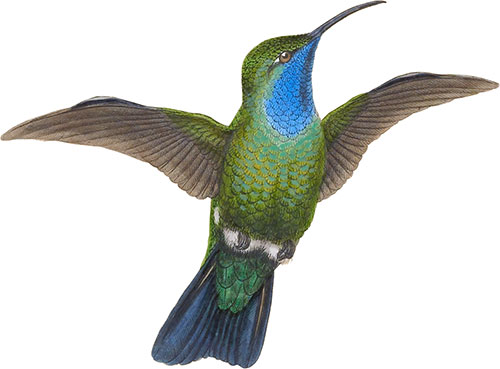Blue-throated Sabre-wing
The Island of Tobago
The Campylopterus ensipennis is one of the most powerful species of the genus.
The boldness of its markings and the brightness of its colouring render it also one of the most beautiful. Although the female is not so brightly coloured as her mate, she assimilates more closely to him in her dress than do the females of the other brilliantly coloured species to theirs; she is, however, somewhat smaller, and has the blue of the throat less conspicuous, and separated from the sides of the face by a white stripe which passes from the base of the bill to beneath the eye.
The West Indian Islands appear to be the native habitat of this fine species: in all probability it also visits some parts of the South American continent, but this has not yet been positively ascertained.
The following extract from Mr. Kirk’s notes on the birds of the island of Tobago, published by Sir William Jardine, Bart., in the twentieth volume of the “ Annals and Magazine of Natural History,” above referred to, comprises all that is at present known respecting this fine bird:—
Feeds on ants, small flies and sweets, and is particularly fond of the blossoms of the wild and common plantain tree; but whether from the circumstance that these blossoms are generally attended by numerous herds of ants, which form the principal part of its food, or for the purpose of extracting sweets, or perhaps both, I am unable to determine; but in all I have dissected, I have found the stomach to contain ants and portions of small gnats. It is found principally in the woods, by rivulets and in low marshy places.
The male has the head, all the upper surface, wing-coverts, sides of the neck, under surface of the body and under tail-coverts deep shining golden-green, passing into grass-green on the upper tail-coverts, and particularly glittering on the nape and back of the neck; wings purplish-brown; chin and throat deep lazuline-blue; two centre tail-feathers greenish-bronze, the next on each side dark steel-blue; the three outer on each side steel-blue at the base, the apical two-thirds being pure white; bill black; feet dark brown.
The female differs in having the blue on the throat less extensive, and separated from the green of the sides of the face by a streak of greyish-white; the centre of the abdomen is also grey.
Like the males of other members of the genus, the very old male of this species has the shaft of the outer primaries very much dilated, which we may suppose adds considerably to its wing-powers.
The Plate represents the birds of the natural size. The plant is the Dipladenia Harrisii.
 Campyloterus lazulus
Lazuline Sabre-wing
Campyloterus lazulus
Lazuline Sabre-wing
 Campylopterus Delattrei
De Lattre’s Sabre-wing
Campylopterus Delattrei
De Lattre’s Sabre-wing
 Campylopterus splendens
Villavicencio’s Sabre-wing
Campylopterus splendens
Villavicencio’s Sabre-wing
 Campylopterus Villavicencio
Villavicencio’s Sabre-wing
Campylopterus Villavicencio
Villavicencio’s Sabre-wing
 Campylopterus latipennis
Broad-shafted Sabre-wing
Campylopterus latipennis
Broad-shafted Sabre-wing
 Campylopterus obscurus
Sombre Sabre-wing
Campylopterus obscurus
Sombre Sabre-wing
 Campylopterus rufus
Fawn-breasted Sabre-wing
Campylopterus rufus
Fawn-breasted Sabre-wing
 Campylopterus hyperythrus
Rufous-breasted Sabre-wing
Campylopterus hyperythrus
Rufous-breasted Sabre-wing
 Campylopterus phainopeplus
Simons’s Sabre-wing
Campylopterus phainopeplus
Simons’s Sabre-wing
Featuring all 422 illustrated species from John Gould’s A Monograph of the Trochilidæ, or Family of Humming-Birds arranged by color.